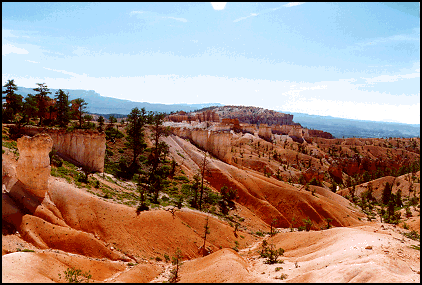

You've probably heard computer terms like "pixels" and "RGB." These terms refer to the ways that computers display pictures and other information on a computer screen or monitor. The display is generally a rectangular array of pixels. Two factors contribute to the amount of information that can be displayed and its appearance -- the number of pixels and their size. One common display has 768 rows of pixels arranged in 1024 columns. If the display is monochrome then the intensity of each pixel can be represented by a real number between zero and one. If the real number associated with a particular pixel is zero then that pixel is black. If the real number associated with a particular pixel is one then the brightness or intensity of that pixel is turned all the way up -- the highest intensity that can be produced on the display. A monochrome picture can be represented by a matrix with the same number of rows as the height of the picture and the same number of columns as its width. For example, the monochrome picture below is represented by a matrix with 285 rows and 422 columns. Each entry in the matrix is a real number between zero and one representing the brightness of a particular pixel.
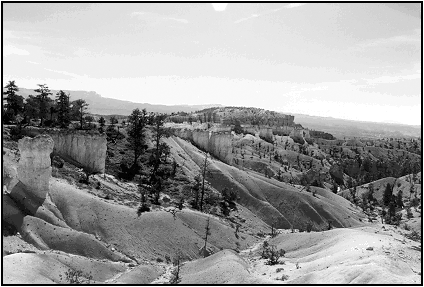
Color displays produce color by combining light with three different colors -- red, green, and blue. The three pictures below shows these three different color components for the picture above from Bryce Canyon.
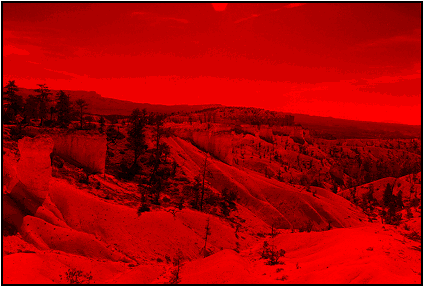
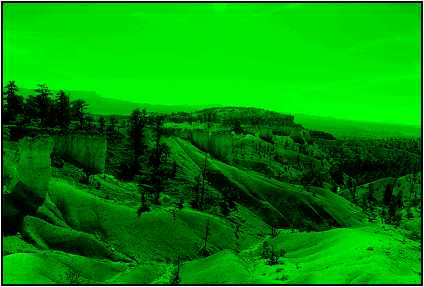
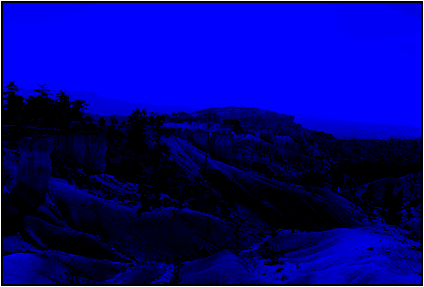
The color picture of Bryce Canyon at the top of this page is represented by three matrices, each of which has 285 rows and 422 columns. Each entry is a real number between zero and one. One matrix represents the red component, one represents the green component, and one represents the blue component. Because pictures are represented by matrices of real numbers they can be manipulated by using mathematics. This is the idea behind the special effects in movies like Star Wars; the lifelike animation in movies like Shrek; and the blurring of reality and virtual reality in movies like Matrix.
In this module you will experiment with manipulating or transforming the colors in the Bryce Canyon picture. The twelve entries in the 3 by 4 form (or matrix) below enable you to produce a new picture based on the original picture but with the colors transformed in various ways. Each of the three rows of the form describes one color component of the new picture. The first row describes the red component of the new picture; the second row describes the green component of the new picture; and the third row describes the blue component of the new picture.
The entry for each color component of each pixel of the new picture is computed by a formula of the form:
For example, suppose you wanted to produce a new picture isolating just the red component of the original picture. You would use the following three formulas:
new red = 0 + 1 * (original red) + 0 * (original green) + 0 * (original blue) new green = 0 + 0 * (original red) + 0 * (original green) + 0 * (original blue) new blue = 0 + 0 * (original red) + 0 * (original green) + 0 * (original blue)
Fill in the 12 entries in the form above using the three formulas above. Then press the Make new picture with transformed colors button to produce a picture isolating just the red component of the Bryce Canyon picture. Depending on the speed of your computer it make take as much as one minute to produce the new picture. The new picture will appear in a new window, so that you can compare the new picture with the original.
To display shades of grey we use the same value for the red, green, and blue components. The three formulas below will convert a color picture to a monochrome picture.
new red = 0 + .333 * (original red) + .333 * (original green) + .333 * (original blue) new green = 0 + .333 * (original red) + .333 * (original green) + .333 * (original blue) new blue = 0 + .333 * (original red) + .333 * (original green) + .333 * (original blue)
Try it.
You can produce a black-and-white negative using the three formulas below.
new red = 1 - .333 * (original red) - .333 * (original green) - .333 * (original blue) new green = 1 - .333 * (original red) - .333 * (original green) - .333 * (original blue) new blue = 1 - .333 * (original red) - .333 * (original green) - .333 * (original blue)
Try it.
Experiments:
Experiment 1: Exchange the colors red and blue.
Experiment 2: Transform red to green; green to blue; and blue to red.
Experiment 3: Produce a color negative.
Experiment 4: Make a new picture that preserves the colors of the original but makes them all darker.
Experiment 5: Make a new picture that preserves the colors of the original but makes them all lighter.
Experiment 6: Make a new picture showing what Bryce Canyon would look like near sunset.
Note: different people may produce different answers for some of these experiments. Be prepared to explain how you interpreted the instructions for each experiment and why you chose that interpretation.
Experiment 7: Be creative. Produce a weird and wild rendition of the Bryce Canyon picture.